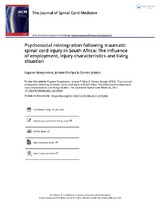| dc.description.abstract | 1Department of Health and Rehabilitation Sciences, Division of Physiotherapy, Stellenbosch University, Cape
Town, South Africa, 2Department of Physiotherapy, University of the Western Cape, Cape Town, South Africa
Objectives: To determine the influence of employment, injury characteristics and living situation on
psychosocial reintegration in individuals who sustained a traumatic spinal cord injury (TSCI) in South Africa.
Design: A cross-sectional exploratory survey.
Settings: Communities of the Cape Metropolitan Area, South Africa.
Participants: A total of 108 community- dwelling adults, between ages of 19 and 71 years, who have sustained a
TSCI more than 1- year ago.
Outcome measures: : The Sydney psychosocial reintegration scale (SPRS-2).
Results: The SPRS-2 and domains mean (SD) scores were: (1) Overall SPRS-2 of 27.87(13.4); (2) Occupational
activity of 8.62 (4.8); (3) Interpersonal relationships of 9.80 (5.1); and (4) Living skills of 9.45 (4.9). Multivariate
regression analysis resulted in two significant independent variables, namely employment and living situation.
Employment alone explained 24.3% of the variance in the overall psychosocial model, 25.6% in the
occupational activity model, while employment together with living situation explained 24.2% of the variance
in the living skills model, with those employed reporting better psychosocial reintegration and those living in
informal dwellings reporting poorer psychosocial reintegration.
Conclusion: Employment and living situation strongly influenced psychosocial reintegration following a TSCI,
indicating the important role of socio-economic status for psychosocial adaptation after injury. As
employment plays a significant mediating role, and living in informal dwellings negatively affect
psychosocial reintegration following a TSCI, rehabilitation stakeholders and policy makers need to continue
lobbying for social and political change that support employment opportunities and provide accessible
housing for persons with TSCI. | en_US |

